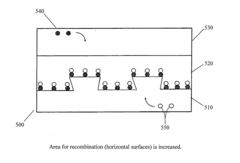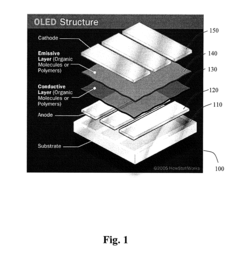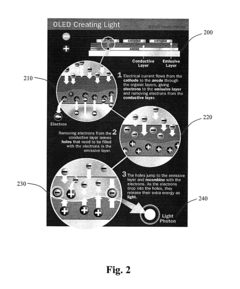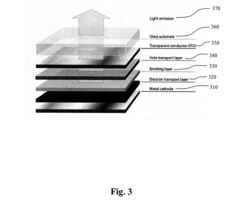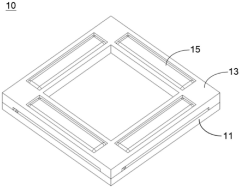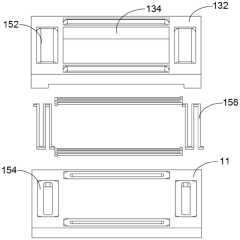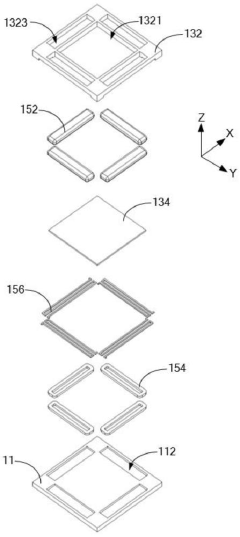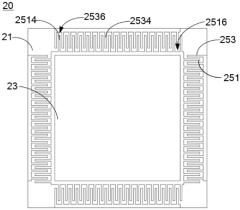ULED vs OLED: A Comparative Analysis
JUN 23, 20259 MIN READ
Generate Your Research Report Instantly with AI Agent
Patsnap Eureka helps you evaluate technical feasibility & market potential.
ULED and OLED Evolution
The evolution of ULED (Ultra Light Emitting Diode) and OLED (Organic Light Emitting Diode) technologies represents a significant advancement in display technology. Both have emerged as leading contenders in the pursuit of superior image quality and energy efficiency.
OLED technology, first developed in the 1980s, saw its commercial debut in the late 1990s. Initially limited to small displays, OLED gradually expanded its application to larger screens, smartphones, and televisions. The technology's ability to produce deep blacks and vibrant colors quickly garnered attention from manufacturers and consumers alike.
ULED, a more recent innovation, was introduced by Hisense in 2015 as a proprietary LCD-based technology. It combines quantum dot technology with local dimming to enhance picture quality and energy efficiency. ULED aims to bridge the gap between traditional LED-LCD displays and OLED, offering improved contrast and color performance at a more competitive price point.
The evolution of OLED has been marked by continuous improvements in manufacturing processes, leading to increased panel sizes, enhanced durability, and reduced production costs. Major milestones include the introduction of flexible OLED displays and the development of white OLED technology for lighting applications.
ULED's evolution has focused on refining its core technologies, including quantum dot color enhancement, local dimming algorithms, and backlight control. Each iteration has brought improvements in contrast ratio, color gamut, and energy efficiency, narrowing the performance gap with OLED.
Both technologies have seen significant advancements in resolution, with 4K and 8K displays becoming increasingly common. HDR (High Dynamic Range) capabilities have also been a key area of development for both ULED and OLED, enhancing the overall viewing experience with improved contrast and color accuracy.
The competitive landscape has driven innovation in both technologies. OLED manufacturers have worked to address concerns about burn-in and lifespan, while ULED developers have focused on improving black levels and viewing angles to compete with OLED's inherent advantages in these areas.
As display technology continues to evolve, both ULED and OLED are exploring new frontiers. OLED is venturing into transparent and rollable displays, while ULED is pushing the boundaries of local dimming zones and quantum dot efficiency. The ongoing development of these technologies promises to shape the future of visual displays across various applications, from consumer electronics to professional and industrial use cases.
OLED technology, first developed in the 1980s, saw its commercial debut in the late 1990s. Initially limited to small displays, OLED gradually expanded its application to larger screens, smartphones, and televisions. The technology's ability to produce deep blacks and vibrant colors quickly garnered attention from manufacturers and consumers alike.
ULED, a more recent innovation, was introduced by Hisense in 2015 as a proprietary LCD-based technology. It combines quantum dot technology with local dimming to enhance picture quality and energy efficiency. ULED aims to bridge the gap between traditional LED-LCD displays and OLED, offering improved contrast and color performance at a more competitive price point.
The evolution of OLED has been marked by continuous improvements in manufacturing processes, leading to increased panel sizes, enhanced durability, and reduced production costs. Major milestones include the introduction of flexible OLED displays and the development of white OLED technology for lighting applications.
ULED's evolution has focused on refining its core technologies, including quantum dot color enhancement, local dimming algorithms, and backlight control. Each iteration has brought improvements in contrast ratio, color gamut, and energy efficiency, narrowing the performance gap with OLED.
Both technologies have seen significant advancements in resolution, with 4K and 8K displays becoming increasingly common. HDR (High Dynamic Range) capabilities have also been a key area of development for both ULED and OLED, enhancing the overall viewing experience with improved contrast and color accuracy.
The competitive landscape has driven innovation in both technologies. OLED manufacturers have worked to address concerns about burn-in and lifespan, while ULED developers have focused on improving black levels and viewing angles to compete with OLED's inherent advantages in these areas.
As display technology continues to evolve, both ULED and OLED are exploring new frontiers. OLED is venturing into transparent and rollable displays, while ULED is pushing the boundaries of local dimming zones and quantum dot efficiency. The ongoing development of these technologies promises to shape the future of visual displays across various applications, from consumer electronics to professional and industrial use cases.
Display Market Dynamics
The display market has witnessed significant shifts in recent years, driven by technological advancements and changing consumer preferences. OLED (Organic Light-Emitting Diode) technology has gained substantial traction, particularly in high-end smartphones and premium televisions. However, the emergence of ULED (Ultra Light-Emitting Diode) technology has introduced a new dynamic to the market, challenging OLED's dominance in certain segments.
OLED displays have experienced robust growth, with their market share expanding across various device categories. This growth is attributed to OLED's superior picture quality, energy efficiency, and flexibility in design. The smartphone sector has been a key driver of OLED adoption, with major manufacturers increasingly incorporating OLED panels in their flagship devices. In the television market, OLED has established itself as a premium option, commanding higher price points and attracting consumers seeking top-tier visual experiences.
ULED technology, while relatively newer, has been making inroads in the display market, particularly in the television segment. ULED displays offer enhanced brightness, improved color accuracy, and competitive pricing compared to OLED counterparts. This has led to increased consumer interest, especially in mid-range to high-end television models. The competitive pricing strategy of ULED manufacturers has put pressure on OLED producers to innovate and optimize their production costs.
The overall display market has shown a trend towards larger screen sizes, higher resolutions, and improved energy efficiency. Both OLED and ULED technologies are well-positioned to capitalize on these trends, each offering unique advantages. OLED excels in producing deep blacks and vibrant colors, while ULED boasts superior brightness and potentially longer lifespan.
Market dynamics are also influenced by regional preferences and regulatory environments. In regions with stricter energy efficiency standards, OLED's lower power consumption may provide a competitive edge. Conversely, in markets where brightness is a key selling point, ULED displays may find greater traction.
The supply chain for both technologies plays a crucial role in market dynamics. OLED production has been dominated by a few key players, leading to potential supply constraints and higher costs. ULED, with its roots in LCD technology, benefits from a more diverse and established supply chain, potentially offering greater flexibility in production and pricing.
As the display market continues to evolve, the competition between ULED and OLED is likely to intensify. This rivalry is expected to drive further innovation, potentially leading to hybrid technologies that combine the strengths of both approaches. The market's future trajectory will depend on factors such as technological advancements, production scalability, and shifting consumer preferences.
OLED displays have experienced robust growth, with their market share expanding across various device categories. This growth is attributed to OLED's superior picture quality, energy efficiency, and flexibility in design. The smartphone sector has been a key driver of OLED adoption, with major manufacturers increasingly incorporating OLED panels in their flagship devices. In the television market, OLED has established itself as a premium option, commanding higher price points and attracting consumers seeking top-tier visual experiences.
ULED technology, while relatively newer, has been making inroads in the display market, particularly in the television segment. ULED displays offer enhanced brightness, improved color accuracy, and competitive pricing compared to OLED counterparts. This has led to increased consumer interest, especially in mid-range to high-end television models. The competitive pricing strategy of ULED manufacturers has put pressure on OLED producers to innovate and optimize their production costs.
The overall display market has shown a trend towards larger screen sizes, higher resolutions, and improved energy efficiency. Both OLED and ULED technologies are well-positioned to capitalize on these trends, each offering unique advantages. OLED excels in producing deep blacks and vibrant colors, while ULED boasts superior brightness and potentially longer lifespan.
Market dynamics are also influenced by regional preferences and regulatory environments. In regions with stricter energy efficiency standards, OLED's lower power consumption may provide a competitive edge. Conversely, in markets where brightness is a key selling point, ULED displays may find greater traction.
The supply chain for both technologies plays a crucial role in market dynamics. OLED production has been dominated by a few key players, leading to potential supply constraints and higher costs. ULED, with its roots in LCD technology, benefits from a more diverse and established supply chain, potentially offering greater flexibility in production and pricing.
As the display market continues to evolve, the competition between ULED and OLED is likely to intensify. This rivalry is expected to drive further innovation, potentially leading to hybrid technologies that combine the strengths of both approaches. The market's future trajectory will depend on factors such as technological advancements, production scalability, and shifting consumer preferences.
Technical Challenges
ULED (Ultra Light Emitting Diode) and OLED (Organic Light Emitting Diode) technologies face distinct technical challenges in their development and implementation. Both display technologies aim to provide superior image quality, but encounter different obstacles in achieving optimal performance.
For ULED, one of the primary challenges lies in achieving uniform light distribution across the panel. The use of quantum dot technology, while enhancing color gamut, presents difficulties in maintaining consistency in light emission. This can result in potential hotspots or uneven brightness across the display, particularly in larger screen sizes.
Another significant hurdle for ULED is the complexity of the backlight system. The multi-layer structure required for local dimming and quantum dot enhancement increases manufacturing complexity and costs. Balancing the trade-off between the number of dimming zones and production expenses remains an ongoing challenge for manufacturers.
OLED technology, on the other hand, grapples with different sets of technical issues. One of the most persistent challenges is the phenomenon of burn-in or image retention. This occurs when static images are displayed for extended periods, causing permanent damage to the organic compounds in the pixels. Mitigating this effect without compromising on image quality continues to be a focus of research and development efforts.
Lifespan and degradation of organic materials pose another significant challenge for OLED displays. The blue OLED emitters, in particular, tend to have shorter lifespans compared to red and green, leading to color shift over time. Improving the stability and longevity of these organic compounds is crucial for ensuring consistent performance throughout the display's lifetime.
Power efficiency is an area where both technologies face challenges, albeit in different ways. ULED displays, due to their backlight system, generally consume more power than OLED. However, OLED struggles with power efficiency at higher brightness levels, which can impact battery life in mobile devices.
Manufacturing scalability presents unique challenges for each technology. ULED production can leverage existing LCD manufacturing infrastructure, but the addition of quantum dot layers and advanced local dimming systems increases complexity. OLED manufacturing, particularly for larger screens, faces yield issues and high production costs, limiting its widespread adoption in certain market segments.
As both technologies continue to evolve, addressing these technical challenges remains crucial for their respective advancements and market competitiveness. Ongoing research and development efforts focus on overcoming these hurdles to deliver improved display performance, longevity, and cost-effectiveness.
For ULED, one of the primary challenges lies in achieving uniform light distribution across the panel. The use of quantum dot technology, while enhancing color gamut, presents difficulties in maintaining consistency in light emission. This can result in potential hotspots or uneven brightness across the display, particularly in larger screen sizes.
Another significant hurdle for ULED is the complexity of the backlight system. The multi-layer structure required for local dimming and quantum dot enhancement increases manufacturing complexity and costs. Balancing the trade-off between the number of dimming zones and production expenses remains an ongoing challenge for manufacturers.
OLED technology, on the other hand, grapples with different sets of technical issues. One of the most persistent challenges is the phenomenon of burn-in or image retention. This occurs when static images are displayed for extended periods, causing permanent damage to the organic compounds in the pixels. Mitigating this effect without compromising on image quality continues to be a focus of research and development efforts.
Lifespan and degradation of organic materials pose another significant challenge for OLED displays. The blue OLED emitters, in particular, tend to have shorter lifespans compared to red and green, leading to color shift over time. Improving the stability and longevity of these organic compounds is crucial for ensuring consistent performance throughout the display's lifetime.
Power efficiency is an area where both technologies face challenges, albeit in different ways. ULED displays, due to their backlight system, generally consume more power than OLED. However, OLED struggles with power efficiency at higher brightness levels, which can impact battery life in mobile devices.
Manufacturing scalability presents unique challenges for each technology. ULED production can leverage existing LCD manufacturing infrastructure, but the addition of quantum dot layers and advanced local dimming systems increases complexity. OLED manufacturing, particularly for larger screens, faces yield issues and high production costs, limiting its widespread adoption in certain market segments.
As both technologies continue to evolve, addressing these technical challenges remains crucial for their respective advancements and market competitiveness. Ongoing research and development efforts focus on overcoming these hurdles to deliver improved display performance, longevity, and cost-effectiveness.
ULED vs OLED Solutions
01 ULED and OLED display structures
Both ULED (Ultra Light Emitting Diode) and OLED (Organic Light Emitting Diode) technologies are used in display devices. They have different structures and manufacturing processes, but both aim to provide high-quality, energy-efficient displays. ULEDs typically use inorganic materials, while OLEDs use organic compounds. The structures of these displays often include multiple layers such as electrodes, emission layers, and substrate materials.- ULED and OLED display structures: Both ULED (Ultra Light Emitting Diode) and OLED (Organic Light Emitting Diode) technologies are used in display devices. These structures typically include multiple layers such as substrate, electrodes, light-emitting layers, and encapsulation. The specific arrangement and materials used in these layers can vary between ULED and OLED, affecting their performance characteristics.
- Pixel circuit designs for ULED and OLED displays: Advanced pixel circuit designs are crucial for both ULED and OLED displays to improve image quality, power efficiency, and lifespan. These circuits often include transistors, capacitors, and other components arranged in specific configurations to control the light emission of each pixel. Innovations in this area focus on reducing power consumption, improving brightness control, and addressing issues like non-uniformity and degradation over time.
- Manufacturing processes for ULED and OLED displays: The manufacturing processes for ULED and OLED displays involve several steps, including substrate preparation, deposition of various layers, patterning, and encapsulation. Innovations in these processes aim to improve yield, reduce costs, and enhance the overall quality of the displays. This may include advancements in deposition techniques, patterning methods, and materials used in the fabrication process.
- Color conversion and enhancement techniques: Both ULED and OLED technologies employ various color conversion and enhancement techniques to improve color gamut, accuracy, and efficiency. These may include the use of quantum dots, color filters, or other materials to convert light from one wavelength to another or to enhance specific color components. Such techniques can lead to displays with more vibrant and accurate colors while potentially reducing power consumption.
- Integration of ULED and OLED with other technologies: ULED and OLED technologies are often integrated with other advanced display technologies or sensing systems to create multi-functional devices. This can include the incorporation of touch sensors, fingerprint sensors, or other interactive elements directly into the display structure. Such integrations aim to improve device functionality, reduce overall thickness, and enhance user experience in various applications such as smartphones, tablets, and wearable devices.
02 Light emission mechanisms in ULED and OLED
ULED and OLED technologies have distinct light emission mechanisms. ULEDs often utilize quantum dot technology to produce light, while OLEDs rely on organic compounds that emit light when an electric current is applied. Both technologies aim to achieve high color accuracy, brightness, and energy efficiency. The specific materials and designs used in each technology affect their performance characteristics.Expand Specific Solutions03 Manufacturing processes for ULED and OLED displays
The manufacturing processes for ULED and OLED displays differ significantly. ULED production often involves techniques such as photolithography and thin-film deposition, while OLED manufacturing may use methods like vapor deposition or solution processing. Both technologies require precise control over material deposition and patterning to create the complex layered structures necessary for their operation.Expand Specific Solutions04 Driving circuits and control methods for ULED and OLED displays
ULED and OLED displays require specialized driving circuits and control methods to operate efficiently. These may include techniques for managing power consumption, controlling brightness levels, and implementing features such as local dimming. The specific requirements for driving circuits can vary between ULED and OLED technologies due to their different operating principles and characteristics.Expand Specific Solutions05 Applications and advantages of ULED and OLED technologies
ULED and OLED technologies find applications in various fields, including televisions, smartphones, and automotive displays. Each technology offers distinct advantages in terms of picture quality, energy efficiency, and form factor. ULEDs often excel in brightness and longevity, while OLEDs are known for their deep blacks and flexible display possibilities. The choice between ULED and OLED depends on specific application requirements and desired display characteristics.Expand Specific Solutions
Key Industry Players
The ULED vs OLED competition is at a critical juncture, with both technologies vying for dominance in the display market. The industry is in a mature growth phase, with a global market size expected to reach $200 billion by 2025. OLED technology, championed by Samsung Display and LG Display, has achieved significant maturity and market penetration. However, ULED, developed by companies like BOE Technology Group and China Star Optoelectronics, is rapidly advancing as a cost-effective alternative. The technological landscape is dynamic, with firms like Merck Patent GmbH and Eastman Kodak Co. contributing to innovations in both fields, intensifying the competition and driving further advancements in display technology.
BOE Technology Group Co., Ltd.
Technical Solution: BOE has developed advanced ULED (Ultra LED) technology, which combines quantum dot technology with Mini-LED backlighting. This approach allows for precise local dimming, enhancing contrast ratios and color accuracy. BOE's ULED panels utilize thousands of Mini-LED zones for backlighting, enabling HDR performance that rivals OLED. The company has also implemented AI-driven algorithms to optimize image quality and power efficiency in real-time, adapting to different content types and ambient lighting conditions.
Strengths: Higher brightness capabilities than OLED, potentially longer lifespan, and reduced risk of burn-in. Weaknesses: More complex manufacturing process, potentially higher cost compared to traditional LCD, and slightly inferior black levels compared to OLED.
Samsung Display Co., Ltd.
Technical Solution: Samsung Display has been at the forefront of OLED technology development, particularly in the mobile and TV markets. Their latest OLED panels utilize advanced materials and pixel structures to improve efficiency and longevity. Samsung has implemented technologies such as quantum dot color conversion layers (QD-OLED) to enhance color volume and brightness. They have also developed variable refresh rate OLED panels that can dynamically adjust from 1Hz to 120Hz, optimizing power consumption while maintaining smooth motion performance.
Strengths: Excellent contrast ratios, perfect blacks, wide viewing angles, and potential for flexible displays. Weaknesses: Risk of burn-in, lower peak brightness compared to some LED technologies, and higher production costs for large panels.
Core Display Patents
Method and system for an organic light emitting diode structure
PatentInactiveUS20150303396A1
Innovation
- Incorporating a plurality of spaced inverted non-cylindrical nano-pillars in the structure of OLEDs, specifically between the emissive and conductive layers, to broaden the carrier recombination space and reduce carrier accumulation, thereby enhancing light extraction and efficiency.
ULED packaging structure and imaging device
PatentPendingCN116741909A
Innovation
- By introducing a drive reset component into the uLED packaging structure, the drive frame moves in the second direction relative to the substrate to provide a reset force, using the persistence of vision of the human eye to reduce the impact of unlit uLEDs, stabilize imaging quality, and achieve a compact structure. change.
Environmental Impact
The environmental impact of display technologies is a crucial consideration in the comparative analysis of ULED (Ultra Light Emitting Diode) and OLED (Organic Light Emitting Diode) technologies. Both display types have distinct environmental implications throughout their lifecycle, from production to disposal.
In terms of manufacturing, ULED displays typically require less energy-intensive processes compared to OLEDs. The production of OLED panels involves complex vacuum deposition techniques and the use of rare earth materials, which can have a higher environmental footprint. ULEDs, on the other hand, utilize more conventional LED manufacturing processes, potentially resulting in lower emissions and resource consumption during production.
Energy efficiency during operation is a key factor in environmental impact. OLEDs have an advantage in this aspect, as they can achieve perfect blacks by turning off individual pixels, leading to lower power consumption in dark scenes. ULEDs, while highly efficient, still require backlighting, which can result in slightly higher energy usage. However, the difference in energy consumption between high-quality ULED and OLED displays has narrowed significantly in recent years.
Lifespan and durability also play a role in environmental considerations. ULED displays generally have a longer lifespan compared to OLEDs, which can be prone to burn-in and degradation over time. A longer lifespan means less frequent replacement, reducing electronic waste and the need for new manufacturing.
The materials used in these displays have different environmental implications. OLEDs contain organic compounds that may be more biodegradable, but they also use rare earth elements that can be environmentally problematic to extract. ULEDs primarily use inorganic materials, which may be less biodegradable but are often more readily recyclable.
End-of-life considerations are crucial for both technologies. OLED panels can be challenging to recycle due to their complex structure and organic materials. ULED displays, being more similar to traditional LED-LCD panels, may have more established recycling processes. However, both technologies require specialized recycling facilities to handle their components properly.
In conclusion, both ULED and OLED technologies have environmental pros and cons. ULEDs may have an edge in manufacturing and longevity, while OLEDs potentially offer better energy efficiency during use. The overall environmental impact depends on factors such as production methods, energy sources, usage patterns, and end-of-life management. As both technologies continue to evolve, ongoing research and development efforts are focused on improving their environmental performance across all stages of their lifecycle.
In terms of manufacturing, ULED displays typically require less energy-intensive processes compared to OLEDs. The production of OLED panels involves complex vacuum deposition techniques and the use of rare earth materials, which can have a higher environmental footprint. ULEDs, on the other hand, utilize more conventional LED manufacturing processes, potentially resulting in lower emissions and resource consumption during production.
Energy efficiency during operation is a key factor in environmental impact. OLEDs have an advantage in this aspect, as they can achieve perfect blacks by turning off individual pixels, leading to lower power consumption in dark scenes. ULEDs, while highly efficient, still require backlighting, which can result in slightly higher energy usage. However, the difference in energy consumption between high-quality ULED and OLED displays has narrowed significantly in recent years.
Lifespan and durability also play a role in environmental considerations. ULED displays generally have a longer lifespan compared to OLEDs, which can be prone to burn-in and degradation over time. A longer lifespan means less frequent replacement, reducing electronic waste and the need for new manufacturing.
The materials used in these displays have different environmental implications. OLEDs contain organic compounds that may be more biodegradable, but they also use rare earth elements that can be environmentally problematic to extract. ULEDs primarily use inorganic materials, which may be less biodegradable but are often more readily recyclable.
End-of-life considerations are crucial for both technologies. OLED panels can be challenging to recycle due to their complex structure and organic materials. ULED displays, being more similar to traditional LED-LCD panels, may have more established recycling processes. However, both technologies require specialized recycling facilities to handle their components properly.
In conclusion, both ULED and OLED technologies have environmental pros and cons. ULEDs may have an edge in manufacturing and longevity, while OLEDs potentially offer better energy efficiency during use. The overall environmental impact depends on factors such as production methods, energy sources, usage patterns, and end-of-life management. As both technologies continue to evolve, ongoing research and development efforts are focused on improving their environmental performance across all stages of their lifecycle.
Manufacturing Processes
The manufacturing processes for ULED (Ultra Light Emitting Diode) and OLED (Organic Light Emitting Diode) displays differ significantly, each with its own unique challenges and advantages.
ULED manufacturing involves a complex process that combines traditional LCD technology with advanced LED backlighting. The process begins with the production of the LCD panel, which includes the creation of thin-film transistors (TFTs) on a glass substrate. This is followed by the assembly of the liquid crystal layer and color filters. The key differentiator in ULED technology lies in its advanced LED backlighting system.
The LED backlighting for ULED displays utilizes a large number of individually controlled LED zones, often numbering in the hundreds or even thousands. These LEDs are precisely placed behind the LCD panel to achieve local dimming and enhance contrast ratios. The manufacturing process requires high precision in LED placement and calibration to ensure uniform brightness and color accuracy across the entire display.
OLED manufacturing, on the other hand, is a fundamentally different process. It involves the deposition of organic materials onto a substrate, typically glass or plastic. The process begins with the creation of the backplane, which includes the TFTs. Following this, layers of organic materials are deposited using techniques such as vacuum thermal evaporation or inkjet printing.
One of the most critical steps in OLED manufacturing is the deposition of the emissive layer, which contains the organic compounds responsible for light emission. This process requires extremely precise control over layer thickness and uniformity to ensure consistent performance across the display. OLED manufacturing also involves the deposition of electron transport layers, hole transport layers, and electrodes.
A significant challenge in OLED manufacturing is the need for a completely dust-free environment, as even microscopic particles can cause defects in the organic layers. This necessitates the use of highly advanced clean room facilities, which adds to the overall manufacturing cost.
Both ULED and OLED manufacturing processes face challenges in scaling up to larger display sizes. For ULEDs, the complexity increases with the number of LED zones required for larger displays. OLED manufacturing becomes more challenging for larger panels due to the increased likelihood of defects over larger areas.
In terms of efficiency, OLED manufacturing has an advantage in that it requires fewer layers and components compared to ULED. However, ULED manufacturing benefits from the maturity of LCD production processes, which can lead to higher yields and potentially lower costs for certain display sizes.
ULED manufacturing involves a complex process that combines traditional LCD technology with advanced LED backlighting. The process begins with the production of the LCD panel, which includes the creation of thin-film transistors (TFTs) on a glass substrate. This is followed by the assembly of the liquid crystal layer and color filters. The key differentiator in ULED technology lies in its advanced LED backlighting system.
The LED backlighting for ULED displays utilizes a large number of individually controlled LED zones, often numbering in the hundreds or even thousands. These LEDs are precisely placed behind the LCD panel to achieve local dimming and enhance contrast ratios. The manufacturing process requires high precision in LED placement and calibration to ensure uniform brightness and color accuracy across the entire display.
OLED manufacturing, on the other hand, is a fundamentally different process. It involves the deposition of organic materials onto a substrate, typically glass or plastic. The process begins with the creation of the backplane, which includes the TFTs. Following this, layers of organic materials are deposited using techniques such as vacuum thermal evaporation or inkjet printing.
One of the most critical steps in OLED manufacturing is the deposition of the emissive layer, which contains the organic compounds responsible for light emission. This process requires extremely precise control over layer thickness and uniformity to ensure consistent performance across the display. OLED manufacturing also involves the deposition of electron transport layers, hole transport layers, and electrodes.
A significant challenge in OLED manufacturing is the need for a completely dust-free environment, as even microscopic particles can cause defects in the organic layers. This necessitates the use of highly advanced clean room facilities, which adds to the overall manufacturing cost.
Both ULED and OLED manufacturing processes face challenges in scaling up to larger display sizes. For ULEDs, the complexity increases with the number of LED zones required for larger displays. OLED manufacturing becomes more challenging for larger panels due to the increased likelihood of defects over larger areas.
In terms of efficiency, OLED manufacturing has an advantage in that it requires fewer layers and components compared to ULED. However, ULED manufacturing benefits from the maturity of LCD production processes, which can lead to higher yields and potentially lower costs for certain display sizes.
Unlock deeper insights with Patsnap Eureka Quick Research — get a full tech report to explore trends and direct your research. Try now!
Generate Your Research Report Instantly with AI Agent
Supercharge your innovation with Patsnap Eureka AI Agent Platform!
